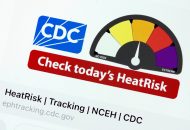Federal Efforts Aim to Combat ‘Silent Pandemic’ of Antimicrobial Resistance

WASHINGTON — A recent study published in the Lancet is the first to provide estimates that the global death toll from antimicrobial resistance is greater than that of HIV or malaria.
“It was our role to provide the most comprehensive results available for these [global health] organizations to help guide policy decision making,” said Mohsen Naghavi, adjunct professor at the Institute for Health Metrics and Evaluation, and one of the co-authors of the study, in an email to The Well News.
Antimicrobial resistance, known as AMR, occurs when changes in bacteria cause drug treatments to become less effective.
The study shows that common and treatable infections, such as an upper respiratory infection, can become deadly when bacteria become resistant to treatment.
AMR has rendered several classes of antibiotics useless against many common infections, including a number of diseases associated with high morbidity and mortality among children, like diarrhea, pneumonia and neonatal sepsis.
It took more than four years for researchers from the Global Research on Antimicrobial Resistance project, known as GRAM, to capture the global death toll of drug-resistant infections for the study.
Researchers assessed data from 204 countries and territories, 23 bacterial pathogens, and 88 drug-pathogen combinations.
They then estimated the increased risk of death for patients infected with drug-resistant bacteria for each pathogen-antimicrobial combination.
The estimates show that 1.27 million people around the world died from antimicrobial-resistant bacterial infections in 2019.
A disproportionate impact of deaths involving infection were observed in low- and middle-income countries.
For example, in South Asia there were 3.8 million deaths associated with infection in 2019 compared to 448,000 deaths associated with infection in the U.S.
“Children under 5 are [also] disproportionately impacted for a variety of reasons. Their immune systems are not fully developed and behaviors such as crawling and putting their hands and objects in their mouths can leave them vulnerable to infection. This risk grows in low resource settings where access to adequate water, sanitation, and hygiene is limited,” said Naghavi.
The report identifies six bacterial pathogens that caused the most deaths associated with resistance, like Staphylococcus aureus, a type of germ that about 30% of people carry in their noses.
It also identifies 12 major infectious syndromes, with lower respiratory infections posing the greatest threat as it accounted for 1.5 million deaths associated with antimicrobial resistance.
Naghavi said global health resources that have appeared in recent years, such as the priority list of drug and pathogen combinations, or the Global Antimicrobial Resistance and Use Surveillance System Report from the World Health Organization, were used to guide the priorities of the study.
“We hope the results in our report will be helpful to these organizations and to the health systems implementing changes to combat AMR,” said Naghavi.
The Office of Pandemics and Emerging Threats at Health and Human Services’ Office of Global Affairs — or PET for short — represents the U.S. in the global negotiations that set the worldwide agenda to address AMR as it threatens to reverse years of progress in modern medicine.
“This is an impressive and much needed study and further illustrates the severity of AMR’s impact on the globe. There have been previous studies and reports that have called attention to the silent pandemic including two CDC threat reports, the U.K.’s Review, and works by international organizations. This report builds upon those efforts and further confirms that we need to act now to finance and implement national action plans for combating AMR,” said representatives from the AMR team at PET, in an email to The Well News.
Since 2014, HHS has included AMR under pandemic preparedness work guided by their National Action Plan to Combat Antibiotic Resistant Bacteria, known as CARB, to lead efforts to capture new forms of resistance that can spread at remarkable speeds around the globe to prevent the possibility of drug-resistant infections.
Still, despite these efforts, out of the seven deadliest drug-resistant bacteria, only two have been a focus of major global health intervention programs, S. pneumoniae and M. tuberculosis.
“The U.S. has taken steps to evaluate our own system and implement changes where we can within our current authorities; we agree more needs to be done,” said representatives from the AMR team at PET.
“There is wide agreement that tangible and accessible solutions to incentivizing antimicrobial development is to revalue antibiotics through novel or modernized reimbursement models,” continued the AMR team at PET.
Between 1980 and 2000, 63 new antibiotics were approved for clinical use, and between 2000 and 2018, just 15 additional antibiotics were approved, according to researchers of the Lancet report.
“Recognizing the importance of this issue, and the impacts it could cause if dedicated action is not taken, we are encouraged to see the PASTEUR Act introduced in Congress and hopeful for its outcome,” said representatives from the AMR team at PET.
The Pioneering Antimicrobial Subscriptions to End Upsurging Resistance Act is a proposal that would create incentives to ensure the availability of critical-need antimicrobial products, and encourage the development of new antimicrobial medicines for the future.
PhRMA, a trade group representing the pharmaceutical industry, released a report last year that outlines there are 90 current medicines in development against drug-resistant infections — including non-traditional antibacterial treatments like monoclonal antibodies — all of which are still in clinical trials and awaiting review by the U.S. Food and Drug Administration.
“That report confirmed what has been warned by other experts — there are too few antimicrobial medicines in development targeting the priority pathogens discussed in new data from The Lancet to meet current and anticipated needs,” said Andrew Powaleny, senior director of public affairs at PhRMA.
“We urge policymakers to examine the growing threat of AMR and advance solutions like the PASTEUR Act,” said Powaleny.
Alexa can be reached at [email protected]























